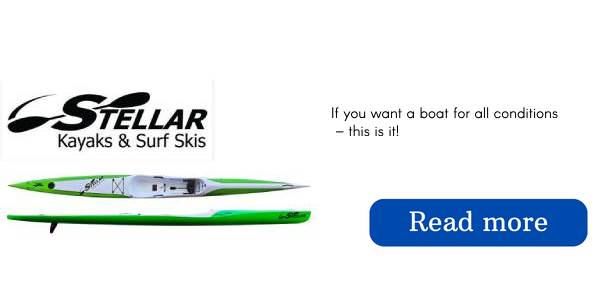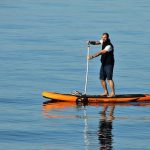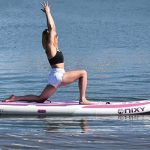While you’re going through the whole process of finding the perfect paddle board for yourself, you might have noticed something interesting about the price ranges (and the SUP market in general):
It is possible for two seemingly indistinguishable boards to have a price gap between $500 and $1000! But why is that?
You can select a kind of SUP, the optimal components, and even settle on a preferred company, but there will still be huge differences between the inexpensive and expensive boards.
So what’s the deal? What factors influence the prices of paddle boards?
Paddle Board Cost Myth-Busting
We understand the cost of paddle boards and the factors that affect prices in the SUP industry due to our success in providing economic paddle boards. The founder of our company wrote a piece for Fast Company in 2013 concerning the manipulation of prices in the paddle board market.
If you look up “how much are paddle boards?” on the internet, you will probably come across a multitude of unreliable facts. You can come across incorrect data concerning paddle board prices authored by deceitful affiliate marketers, as well as people and SUP companies purposefully providing erroneous information to online visitors.
The core message of this misinformation is that, just like with most items, the idea that “you get what you pay for” is often accepted. However, in present times of online and in-person shopping, this theory isn’t necessarily applicable. It is not accurate to say that stand-up paddle boards fall within a certain cost range in the current market.
Sales Channel Affects Paddle Board Pricing the Most
The cost of stand-up paddle boards can vary significantly, ranging from as low as $200 to as high as $3,000. The notion of “you get what you pay for” implies that procuring a cost-effective board means you are receiving an inadequate item, but the pricey boards are only meant for unique applications, thus indicating that you should acquire a paddle board valued somewhere in the middle. That sounds good, but it’s baloney.
The actual cost of a paddle board is not determined by the standard of the commodity you obtain, but by the circulation of promotions and the set cost of the trademark.
Retail Store SUP Pricing
Most paddle boards are bought at a so-called ‘normal’ retail shop, and usually for about three to five times what it cost to make it. If a factory creates a SUP board for $350, you would likely buy it from a retail shop for somewhere in between $1,050 and $1,750.
You will also be aware that the store has done its due diligence in examining the product. If the board does not perform well and is frequently given back, the merchant must contend with the return, ultimately leading to the short lifespan of that item on their inventory.
Shops provide you with a chosen number of brands and the benefit of convenience however, you will incur a cost for that comfort. Retail stores involve numerous mediators: the producer, the trademark, representatives, sales agents, transportation to shift items, the retail location themselves, as well as publicity and advertising and marketing.
The $350 it cost to create the item in a factory increases to $1,400 due to the numerous layers of businesses and intermediaries who each get a piece of the profit.
Within retail, however, different retailers operate on different margins. A big store like Walmart or Costco have a lot of cost saving due to their size, allowing them to sell products at a much lower cost than a shop specializing in SUP or even a smaller store like Dick’s Sporting Goods.
If you are determined to shop at retail stores, going for a Costco stand up paddleboard may be your most viable option; however, be mindful that the kinds of SUP sold at Costco may not last for long, as Costco has been known for discarding the manufacturers of these boards after a certain period of time.
It is essential to keep in mind that a great number of ISUPs bought at Costco have to be sent back, so it is likely that you will need to make a return for the board you get.
Direct to-Consumer SUP Pricing
When selling directly to consumers, the cost to produce a paddle board is $350, and we need to only increase the price by once. The production cost of a retail store’s paddle board might be much lower than the selling price, with Amazon taking half of that value.
Nonetheless, we should aim to raise the price just a bit more than what it took to produce the item, in order to establish stability and sustainability as a brand over an extended period of time.
Average Cost Of A Paddle Board: How Much Are Paddle Boards?
There’s a lot to “unpack” here. The cost of a paddle board is ultimately determined by the type of model you are looking to buy.
Inflatable Paddle Boards
So, how much do inflatable paddle boards cost? And, are they cheaper than rigid boards?
Inflatable SUP boards generally cost less than rigid SUPs. The prices of these items vary immensely, ranging anywhere from $200 to $1800, allowing customers a great deal of selection.
The optimum price range is from $600-1200, with more features and higher quality offered in comparison to the cost. Boards that are sold for a price of $1000 or greater are usually created with multiple PVC layers, which provides better protection.
It is also more likely that the product will come with a large number of drop stitches and seam welds, both of which increase the board’s durability.
In addition to this, usually the cost is increased for extra features or for an inflatable paddle board that can be altered into a kayak.
Hard Paddle Boards
Generally, a hard stand-up paddle board will cost somewhere between $700 and $2,000. So why are they more expensive?
It costs more in terms of time, resources, and funds to make solid SUPs than the inflatable ones. The quantity of materials used is not the only important factor; what matters is the selection of materials too. High-grade PVC paddle boards are still a good value in comparison to those made from fiberglass, wood, kevlar, or epoxy.
Boards priced between $700 and $1100 are designated for use as all-around stand-up paddle (SUP) boards. These do pretty much okay in all weather and are great for rookies who still need to practice their paddle boarding techniques.
All-Around Paddle Boards
Paddle boards that are suitable for all kinds of situations are the perfect choice for any novice or leisurely paddler. The prices usually vary from around $600 to roughly $1500, depending on the type.
In general, SUPs are designed to serve multiple purposes and are usually of the same shape, however, there may be one or two significant features that stand out.
Surf Paddle Boards
Although an all-purpose board could sufficient to surf on, some people prefer to get a board that is tailored to those conditions. How much should you expect to spend, then? This is still quite expensive; a low-end surf paddle board will set you back around $1000.
The reason?
Surfboard paddles require a complex design, particularly when it comes to the type of rails needed for surfing moves. Despite being smaller than other hard boards, the considerable expense to acquire one is due to the combination of rails, broader deck comfort pads, and kick pads necessary for pivots and changes while surfing the waves.
It is essential to invest more in a competent paddle board, as buying a cheaper model will likely prevent you from properly enjoying the surf.
Racing Paddle Boards
A clear illustration of the “You get what you pay for” phenomenon can be seen in racing paddle boards. The price range for racing SUPs starts at $850.
For less money you can acquire a decent board, but if you are willing to spend up to $2000, you can likely find one that is higher quality and will provide a better experience.
The reason is simple:
The capabilities of Racing SUPs are determined by the use of more superior materials and more complicated construction choices. Generally, longer than the norm SUPs, yet the quantity of materials used is of less importance.
The emphasis here is solely on power – the prolonged and intricate construction processes utilized to build a racing SUP make it expensive. However, these items offer what is most important in this area – swiftness and steadiness.
Whitewater Paddle Boards
Whitewater paddle boarding is no joke. A SUP that is sturdy and long-lasting is necessary for a safe journey for both of you. It’s typical to expect to spend around $800 and with that you’ll receive either an inflatable with great quality or a solid board that is on the inexpensive side with some extras and perks.
Inflatable SUPs do offer convenience and durability. Subsequently, inflexible SUPs furnish far superior maneuverability and steadiness. Boards suitable for paddle boarding on white water can be purchased, but they usually cost in the realm of $1200.
Investigate the deck pad, D-rings, tie downs, a rear kick pad to stabilize your back foot, and fin set-up created specifically for whiteboarding to make sure you have the best hold.
The cost of the most advanced whitewater stand-up paddle boards may be high – as much as $1800 – but the improvements make them worth the extra money.
Fishing Paddle Boards
The cost of fishing paddle boards appears too good to be true. You can purchase a midrange model for approximately $800, but the highest quality models can be as expensive as $2500.
It might seem strange, but it’s pretty simple:
You could think that the top of the range SUP boards have so many specific features that it’s almost like you have a full-sized fishing boat just in the shape of a board.
These stand-up paddle boards provide an awesome paddle boarding opportunity overall – not only for angling. It is worth noting that cheaper paddle boards designed for angling can be a good option – particularly if you do not require a lot of additional features.
Kids Paddle Boards
The market for “kids paddle board” SUPs is the most straightforward when contrasted with other kinds of SUPs. The majority of models have been created to enable your children to have the fullest experience possible while out on the water, allowing them to learn and discover.
The range of prices begins roughly at $500 and may reach up to roughly $800.
When considering an inflatable Stand Up Paddleboard for kids, it is important to make sure it is both durable and comfortable. However, with a bit of research, you can be sure to find a great one that is both straightforward and youth-friendly.
Yoga Paddle Boards
The price of the product varies from around $500 and can reach up to $1300 for those who want extra features.
Yoga SUP (stand-up paddleboards) should be straightforward and uncomplicated. Having storage options and accessories on a board like this is beneficial, however the most important basics to consider are balance and comfort.
And that’s where an inflatable board comes in:
A hard platform isn’t suitable for this situation; you require an inflatable SUP’s cushioned, more comfortable deck.
SUP Kayak Hybrid
Certainly, it’s not the most classic kind of SUP board, but, if you’re someone who enjoys a great bargain, you won’t be disappointed with a combination SUP-kayak. Depending on the characteristics, these items can usually be bought somewhere between $800 and $1200, which is a great deal for what you’re obtaining.
These boards have two varieties, but they come with different costs.
The more economical and economical alternative is the called “Paddle board Plus.” It can be fitted with D-rings to secure a second section that converts a stand-up paddleboard into a kayak.
The other alternative, which may cost more, is a hybrid of paddle board and kayak, featuring a shallow and solid hull that looks like an unroofed kayak and the upper part is usable as a board.
Family Paddle Boards
The price tag of family-sized stand up paddle boards begins at approximately $800. The amount you spend is typically correlated with the size of your family. SUPs that are more pricey can cost anywhere between $1500 and $1500, and at the higher-end of the board range, there are some really well-made boards with superior materials.
Certainly, there are some diverse options in these as well. Inflatable versions are well liked because they have much greater weight limits than solid models. It is essential to consider the load bearing capacity and how it is distributed for clear reasons.
Here’s one thing to remember when buying a family SUP:
Young children could sit on the board at present, however your offspring will grow up rapidly. So, leaving some wiggle room capacity-wise is highly recommended.




